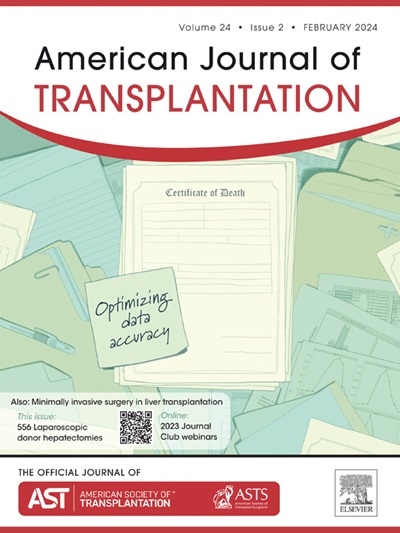Renal resistance trajectories during hypothermic machine perfusion in kidneys donated after circulatory death: Associations with donor characteristics and posttransplant outcomes—An analysis of COMPARE trial data
IF 8.2
2区 医学
Q1 SURGERY
引用次数: 0
Abstract
Renal resistance (RR) during hypothermic perfusion is commonly used as a factor to assess kidney quality, with most studies focusing on terminal RR measurements. We fitted a linear model to the entire RR trajectory using data from the randomized Consortium for Organ Preservation in Europe COMPARE trial and explored the relationship between the RR trajectory, donor characteristics, and posttransplant outcomes, also assessing the prognostic value of terminal RR for delayed graft function (DGF). Donor weight (F = 5.32; P = .005) and cause of death (F = 2.91; P = .008) were associated with the RR trajectory, whereas active oxygenation had no effect (F = 1.12; P = .33). The RR trajectory did not predict DGF (F = 1.93; P = .15), biopsy-proven acute rejection (F = 0.41; P = .66), 1-year kidney function (F = 0.61; P = .54), or 1-year graft survival (F = 0.47; P = .63). Terminal RR independently predicted DGF (odds ratio 1.14; 95% CI, 1.009-1.298; P = .03) but had limited prognostic value (area under the receiver operating characteristic curve, 0.63; 95% CI, 0.55-0.71), aligning with previous research. Our findings suggest that the RR trajectory reflects the kidney’s intrinsic response to perfusion, with donor weight and cause of death potentially influencing its progression. The absence of a relation between the RR trajectory and posttransplant outcomes stresses that using RR as a standalone criterion for kidney discard is not justified and may lead to unnecessary discard. Our findings also call for further validation in larger, more diverse cohorts.
循环性死亡后捐赠肾脏在低温机器灌注期间的肾阻力轨迹:与供体特征和移植后结果的关联——一项比较试验数据分析
低温灌注时肾阻力(RR)常被用作评估肾脏质量的一个因素,大多数研究都集中在终末RR的测量上。我们使用随机COPE-COMPARE试验的数据拟合了整个RR轨迹的线性模型,并探讨了RR轨迹、供体特征和移植后结果之间的关系,同时评估了晚期RR对延迟移植功能(DGF)的预后价值。供体重量(F=5.32;p=0.005)和死因(F=2.91;p=0.008)与rr轨迹相关,而活性氧无影响(F=1.12;p = 0.33)。rr -轨迹不能预测DGF (F=1.93;p=0.15),活检证实急性排斥反应(F=0.41;p=0.66), 1年肾功能(F=0.61;p=0.54),或1年移植物存活率(F=0.47;p = 0, 63)。终末RR独立预测DGF [OR 1.14 (1.009-1.298), p=0.03],但预后价值有限[AUC 0.63(0.55-0.71)],与既往研究一致。我们的研究结果表明,rr轨迹反映了肾脏对灌注的内在反应,供体体重和死亡原因可能影响其进展。RR轨迹与移植后结果之间关系的缺失强调了将RR作为肾脏丢弃的独立标准是不合理的,可能导致不必要的丢弃。我们的研究结果还需要在更大、更多样化的人群中进一步验证。
本文章由计算机程序翻译,如有差异,请以英文原文为准。
求助全文
约1分钟内获得全文
求助全文
来源期刊
CiteScore
18.70
自引率
4.50%
发文量
346
审稿时长
26 days
期刊介绍:
The American Journal of Transplantation is a leading journal in the field of transplantation. It serves as a forum for debate and reassessment, an agent of change, and a major platform for promoting understanding, improving results, and advancing science. Published monthly, it provides an essential resource for researchers and clinicians worldwide.
The journal publishes original articles, case reports, invited reviews, letters to the editor, critical reviews, news features, consensus documents, and guidelines over 12 issues a year. It covers all major subject areas in transplantation, including thoracic (heart, lung), abdominal (kidney, liver, pancreas, islets), tissue and stem cell transplantation, organ and tissue donation and preservation, tissue injury, repair, inflammation, and aging, histocompatibility, drugs and pharmacology, graft survival, and prevention of graft dysfunction and failure. It also explores ethical and social issues in the field.

 求助内容:
求助内容: 应助结果提醒方式:
应助结果提醒方式:


